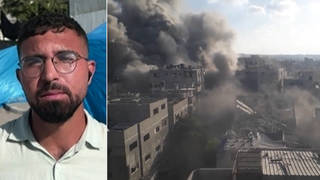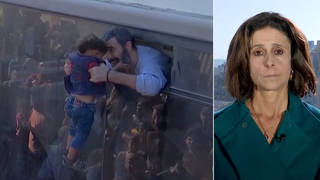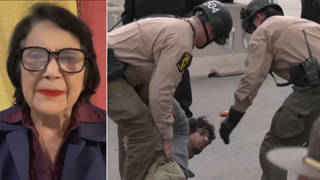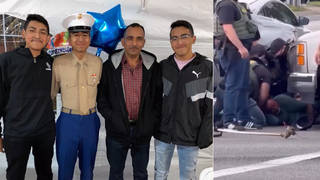
Topics
New York Mayor Rudolph Giuliani’s unsympathetic response to the fatal police shooting of an unarmed black man could change the course of the New York Senate race. A Zogby poll taken after the slaying of twenty-six-year-old Patrick Dorismond shows that Giuliani’s seven-point lead over First Lady Hillary Rodham Clinton has vanished and that Clinton now holds a slight lead over the mayor. [includes rush transcript]
Meanwhile, Representative Patrick Kennedy said yesterday that a federal review is underway into the shooting death of a black policeman shot by two white officers who said they mistook him for a suspect. Kennedy said he spoke with two Department of Justice officials about Sergeant Cornel Young, Jr., the off-duty black officer fatally shot on January 28. Civil rights leaders have repeatedly demanded an independent investigation into the case.
Recent fatal shootings by police around the country have put the aggressive, zero-tolerance style of policing under question. Some are advocating a more community-oriented approach that also addresses crime, but without trampling on the civil rights of the general public.
Guest:
- Lynn A. Curtis, President of the Milton S. Eisenhower Foundation. He has been working with police departments in cities such as Boston and Columbia, South Carolina on community policing programs. Call: 202.429.0440.
Related link:
Transcript
AMY GOODMAN:
If you listened to yesterday’s show, you’ll know that we don’t have our regular technical director with us today, Errol Maitland. Errol Maitland is in the intensive coronary care unit at Kings County Hospital in Brooklyn. For forty-eight hours, he was shackled to the bed there and in the emergency room, and he has been under police guard until last night. Why? Because he was covering the funeral of Patrick Dorismond, the Haitian American who was killed by police two weeks ago outside of a bar.
Three undercover police officers who came up to him and asked him if he had drugs and knew where to buy drugs, and after that, ultimately Patrick Dorismond was shot dead by the police officers. He was a twenty-six-year-old security guard. Tensions were very high this weekend at the funeral, a great deal of emotion as thousands of people marched from the funeral home to the church, where the funeral was held. And then — then he was buried, Patrick Dorismond.
Errol was out in the crowd talking to people, talking to police, giving live reports on Pacifica station WBAI with his cell phone. As he was asking police to describe the situation after the funeral, when riot police moved in, he was taken down. He was attacked by the police. He was thrown on his face. He was handcuffed. He was brought to the police precinct. His lawyer, because he was complaining of chest pains and shortness of breath, wanted to make sure he got medical attention, which had been denied. He was brought to the hospital and then admitted into the intensive coronary care unit, where he is now. Today at 10:30 Eastern Time in the morning, there is a news conference that’s being held at WBAI, the Pacifica station here in New York that Errol was reporting for. His lawyer will be here, as well as witnesses to what happened, demanding that the charges be dropped against Errol.
And talking about issues of investigating the police, one of my colleagues this morning, Janice K. Bryant, joked in a not-very situation, that this is the new forty-eight-hour rule. See, in New York, it’s one of the only places in the country that has a forty-eight-hour rule for police. That is, after they’ve been involved in a shooting, they are allowed forty-eight hours where they don’t speak to anyone, while Errol has a forty-eight-hour rule enforced on him. He is reporting. We listen live as he’s taken down by the police, and then for forty-eight hours he’s held by police under police guard and shackled to a bed.
I tried to see him on Saturday night in the emergency room, where he was a hooked up to monitors and machines and IV, and the police wouldn’t let me go near him. I tried to see him last night after the police said that he was — that they had released him, though he remains in the intensive care unit, but the hospital said he was still under precinct jurisdiction, even though the police were putting out information that he was no longer being guarded by police. The hospital then said we couldn’t see him because of precinct jurisdiction. It was only when his lawyer showed up and fought for us that we were able to see him for a few minutes.
My co-host, Juan Gonzalez, who will be with us tomorrow, wrote a very good piece in the New York Daily News today about Errol, saying — and this is Juan’s words — “I went to visit a friend at Brooklyn’s Kings County Hospital early yesterday afternoon but was not allowed to see him. When I got to the hospital, a New York City policeman was standing guard over his bed in the coronary intensive care unit, restricting who could get near him. A nursing supervisor told me, ‘You’ll have to go to the 67th Precinct to get permission.’ My friend’s name is Errol Maitland. He was arrested by cops Saturday afternoon while he was doing his job as a radio journalist covering the funeral of Patrick Dorismond, the unarmed Haitian immigrant shot to death March 16th by an undercover narcotics cop in Manhattan. An observer who saw the arrest says the cops jumped Maitland, who’s forty-nine years old, without provocation. Maitland was able to provide a chilling account of the encounter to a live audience via a cell phone he was carrying. Police initially charged him with disorderly conduct, and two days later he still was shackled to a bed in Kings County under police guard, as if he were some deranged felon.” And then it goes on to talk about Errol.
Tomorrow, we hope to bring you some excerpts of today’s news conference and are demanding some accounting for grassroots reporters on the ground, not protected by barricades or there, protected by cameras, etc., but on the ground with other people just with cell phones or microphones, there to report on what’s happening, where the other reporters usually do not go. And Errol has paid a price, really, for all of us to be able to do our jobs.
And I just want to say that, because I’m usually looking directly at him, and today Matthew Finch is filling in, who is the arts director at WBAI, and I thank you, Matthew, for that. But Errol Maitland is our technical director, and we all stand with him.
And so, today we sre going to take a look at policing and what proper policing looks like. You know the chants of Seattle? “This is what democracy looks like!” Well, we’d like to see what it looks like in the streets of our cities. The Mayor in New York’s unsympathetic response to the fatal shooting of Patrick Dorismond could change the course of the New York Senate race. A Zogby poll taken after the slaying of Dorismond shows that Giuliani’s seven-point lead over First Lady Hillary Rodham Clinton has vanished and that Clinton now holds a slight lead over the Mayor.
Meanwhile, Rhode Island Congressmember Patrick Kennedy said yesterday that a federal review is underway into the shooting of a black policeman in Rhode Island, shot by two white officers who said they mistook him for a suspect. Kennedy said he spoke with two Department of Justice officials about Sergeant Cornel Young, the off-duty black officer fatally shot on January 28. Civil rights leaders have repeatedly demanded an independent investigation into that case. And I don’t know if you around the country have been following that case, but it’s quite remarkable. We’ll deal with the details on another day.
But among the issues, as this black off-duty cop came out of a restaurant with his gun drawn to deal with a situation that he thought he was helping the other police officers with, among the other facts of this case is, one of the cops that he came out to help had trained in the academy with him in the last few years. They had just graduated from the academy, and he still didn’t recognize him.
Well, recent fatal shootings by police around the country have put the aggressive, the zero-tolerance style of policing, under question. Some are advocating a more community oriented approach that also addresses crime, but without trampling on the civil rights of the general public.
We’re joined in the studio by Lynn Curtis, who’s president of the Milton S. Eisenhower Foundation. He’s been working with police departments in cities like Boston, Columbia, South Carolina, on community policing programs. Welcome to Democracy Now!
LYNN CURTIS:
Good morning. How are you?
AMY GOODMAN:
It’s good to be with you. So what is the answer?
LYNN CURTIS:
Well, the reality is you don’t need zero tolerance to create reductions in crime. There’s no scientific evidence that shows that zero tolerance is needed.
AMY GOODMAN:
What do you mean by “zero tolerance”?
LYNN CURTIS:
I mean the excessive use of force that is being used in New York City. I mean pumping forty-one bullets into someone pulling their wallet out. In cities like Boston, the police are tough, but they’re also sensitive to the community, and violent crime went down in Boston roughly as much as in New York, while relations with the community improved. The same thing in Columbia, South Carolina. The same thing in San Diego.
There are also cities over the last decade, like San Francisco, which did nothing much in terms of police reform, and violent crime went down about as much as in New York. There was one city, East Saint Louis, Illinois, where the cops didn’t have enough money for enough cruisers, and still violent crime went down as much as in New York City. So there are other things operating that are responsible for the drops in violent crime, including sensitive ways in which minority officers, for example, can work with youth in public housing, as is being done in Columbia, South Carolina.
AMY GOODMAN:
How?
LYNN CURTIS:
There are police mini stations, which share the same space as youth safe havens where kids come after school for some food and some help with their homework. And officers are trained to mentor the kids and work with nonprofit community organizations. You can say, oh, this is social work. Well, if it’s social work and it reduces crime and it improves relations with the community, then so be it.
AMY GOODMAN:
I can only think of one of the police officers who killed Amadou Diallo, his statement on the stand when asked why he didn’t step back rather than move forward. He said, “I wasn’t trained to wait.” And in a funny way, you’re talking about waiting in a much bigger sense. You’re talking about observing situations. You’re talking about dealing with situations before they become so tense that you’re out on the streets.
LYNN CURTIS:
And more broadly, I’m talking about how not only zero-tolerance, but prison building [inaudible] in the media all the time as the reasons why crime has dropped are not very successful, in fact, and are racially biased, whereas on the other hand, there are many other solutions that are very positive, that are preventive, which should be used, which are more cost-effective and that really get at the heart of the matter, in terms of both crime and race.
AMY GOODMAN:
Lynn Curtis is president of the Milton S. Eisenhower Foundation, which has continued the work of the Kerner Commission. Some people may remember that commission, established after the urban rebellions of the 1960s. What came of that, and are you still using their recommendations?
LYNN CURTIS:
Well, there were two commissions by President Johnson in the late ’60s: the Kerner Riot Commission, after the big city riots, and the National Violence Commission, after the assassinations of Reverend King and Senator Kennedy. And we’ve been updating those commissions, and we recently did a thirty-year update. And what we found was that, in a ballpark sense, the levels of violence today are roughly the same as they were back in the late ’60s, and levels of public perceived fear today are the same as they were in the late ’60s. And the only difference is we’ve had a sevenfold increase in prison building, along with new aggressive strategies like zero tolerance, neither of which have worked very well.
AMY GOODMAN:
Can you talk about the issue of crime? We hear that crime is down all over the country.
LYNN CURTIS:
Since 1993, roughly, crime has gone down, and that’s roughly coterminous with the improved economy. What happened when you take a broader look, though, a thirty-year look like we did, comparing the late ’60s to the late ’90s, is that crime shot up in the ’80s during the policies of the Reagan administration and during the big crack epidemic. And then crime shot down in the ’90s with the waning of the crack epidemic and the improved economy, which roughly means that we’re back where we were in the late ’60s. The most prestigious study of crime and prison building was done by the National Academy of Science, and they concluded that the criminal justice response to crime is essentially running in place.
AMY GOODMAN:
And yet, it’s often used as a justification for even more crackdowns and prison building, that crime is down, so this is the answer.
LYNN CURTIS:
Yeah, and to some extent it is wiser to say, well, look, what doesn’t work and what does work? Why don’t we stop doing what doesn’t work and start doing what does work to a scale equal to the dimensions of the problem? which is a quote from the Kerner Commission. Prison building and zero tolerance don’t work. But there are programs that reduce crime and drugs at the same time that they improve employability and improve education. Preschool, like Head Start, works in that way. Safe havens after school where kids go for help with their homework from mentors. The Ford Foundation’s Quantum Opportunity Program, which has adult mentors for kids in inner-city high schools. Or the Argus Learning for Living Center on East 160th Street in the South Bronx, which is a Training First program. All these programs reduce crimes and drugs at the same time that they increase employability and they increase school performance. So you get sort of multiple good outcomes. And those were — that’s where the answers are, not in very narrow-minded categorical programs.
AMY GOODMAN:
How do police departments respond to you?
LYNN CURTIS:
Well, in some cities, they respond well; in some, they don’t. It really depends on the leadership of the mayor and the police chief. In Columbia, South Carolina, for example, the police chief is an African American who is very sensitive and who is also an ordained minister. He is doing police mini stations, combined with youth safe havens all over public housing and now in middle schools, and it’s working real well. Leadership is a big component.
AMY GOODMAN:
Where aren’t they responding so well?
LYNN CURTIS: Well —
AMY GOODMAN: Have you done any work in Los Angeles?
LYNN CURTIS:
Los Angeles is a difficult place, and that’s a good example. It’s also more difficult, because it’s so spread out, and cities that are more spread out kind of — intense walking in the streets and being with the folks is more difficult. New York and LA are the best examples of where this kind of policing isn’t very well received by the powers that be.
AMY GOODMAN:
How can powers that be set a different tone? And how do you approach? Are you called in by police departments?
LYNN CURTIS:
Sometimes we are. What you’ve got to do is just sit down with the police chief and the mayor and see what their agendas are and see if they understand what really works and what doesn’t. And it doesn’t pay to really proceed if a police chief or mayor is blinded to the truth.
AMY GOODMAN:
If a police department wants to change, what do they have to do? What are the first steps?
LYNN CURTIS:
The first steps have to do with training and retraining of their officers and making them sensitive to the community. And in the places —
AMY GOODMAN:
What does that mean?
LYNN CURTIS:
Getting nonprofit groups, for example, to train police in the academy. We’ve done that in some places. Just getting a dialogue going between the police and respected nonprofit inner-city community groups makes a big difference. And then it can build from there. And what you don’t want to do is say here’s our top-down national formula. What you need is a progressive bubble-up kind of process where you have the principle of nonprofit groups working with police. And then you let folks in local communities find the ultimate solutions on their own, based on their own particular circumstances.
AMY GOODMAN:
So that’s one, nonprofit groups training at the police academy, training the police cadets. What’s another?
LYNN CURTIS:
Well, to be based right in the neighborhoods. We started doing police mini stations after looking at how the police do things in Japan. There are thousands of little mini stations in Japanese cities, where the police are there to help you out. If it’s raining, they give you an umbrella. If someone in the neighborhood got into Tokyo University, which is the fanciest school, the police will walk around and tell all the residents of this. There’s a real communal sense by the police themselves. And then we took that notion and we combined it with an American notion of safe havens, where kids go after school. Kids get into the most trouble between 3:30 and 10:00 at night. And so, if you’ve got a place to go, then the chances that you’ll get in trouble are diminished. So, safe havens and mini stations based right in the neighborhood, not in some distant place, seems to let the police relate better to the people.
AMY GOODMAN:
Well, we have to wrap up this conversation. If people want to get in touch with the Eisenhower Foundation, where can they call, Lynn Curtis? Where can they go on the web?
LYNN CURTIS:
www.eisenhower.org. And they can call (202) 429-0440.
AMY GOODMAN:
One more time, that phone number?
LYNN CURTIS:
(202) 429-0440.
AMY GOODMAN:
I want to thank you for being with us, Lynn Curtis, president of the Eisenhower Foundation, which deals with the issue of crime and policing, particularly focusing on community policing.












Media Options